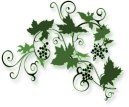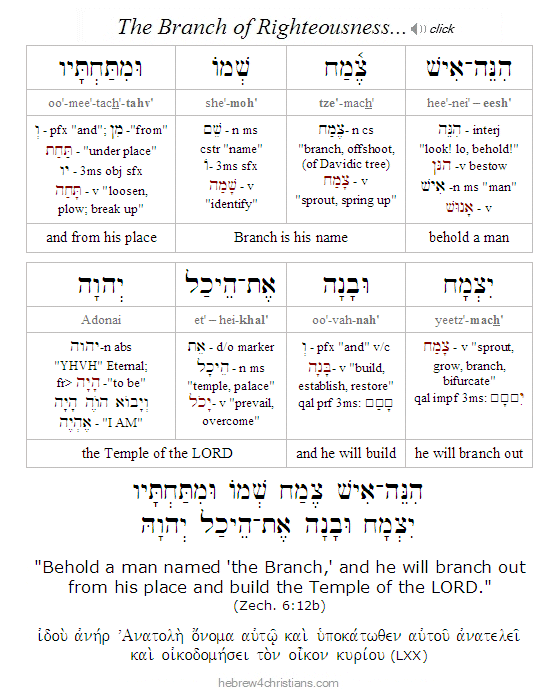|
[ The following article concerns the Haftarah reading from parashat Beha'alotekha. Please read the Haftarah portion to "find your place" here. ]
The Haftarah (i.e., the portion from the prophets) for parashat Beha'alotekha includes reference to the great Tzemach Tzedakah (צֶמַח צְדָקָה) - the "Branch of Righteousness." Tzemach Tzaddik (צֶמַח צַדִּיק) is a metaphorical name for the Messiah, the offshoot of King David (Jer. 33:15). Of him the prophet Zechariah says, "Behold, a man called the Branch (tzemach) shall branch out (יִצְמָח) from the midst of the earth, and he shall build the Temple of the LORD (בָּנָה אֶת־הֵיכַל יְהוָה)" [Zech. 6:12].
This is a "dual aspect" prophecy, like so many others in the Scriptures. The prophet Zechariah initially gave this message to Joshua (Yehoshua ben Yehotzadak) who was the High Priest at the time of the return of the Exile from Babylon, and tzemach may refer to Zerubavel in the immediate context. But note the prophet's parable: "Hear now, O Joshua the high priest, you and your friends who sit before you, for they are men who are a sign: behold, I will bring my servant the Branch" (Zech. 3:8). Shifting metaphors, the prophet then likens this "branch" to a stone: "For behold the stone that I have laid before Joshua; upon one stone shall be seven eyes: behold, I will engrave the graving thereof, saith the LORD of hosts, and I will remove the iniquity of that land in one day" (Zech. 3:9).
The LORD later instructed the prophet to crown Joshua (Zech. 6:10-13) signifying regal authority... So who is this who would combine priestly and kingly power on behalf of Israel and who would "remove the iniquity of the land in one day"? Who is this "Righteous Branch"? The prophecy says, הִנֵּה־אִישׁ צֶמַח שְׁמוֹ / hinei-ish tzemach shmo: "behold the man whose name is the Branch" (Zech. 6:12).

It must be remembered that God's high priest (kohen gadol) was never allowed to wear the crown of a king (separation of "church and state" goes back to the prophecy of Yaakov!). The scepter is Judah's -- and King Messiah would therefore come from the royal tribe of Judah (Gen. 49:10; see elsewhere this site regarding "Shiloh"). This picture, then, of a High Priest wearing the King's crown therefore goes beyond the various roles defined in the Levitical priesthood (i.e., the covenant at Sinai).
The union of anointed King (i.e., Mashiach) and the High Priest was going to "bring peace" to Israel (Zech. 6:13). Yeshua is the One who will ultimately restore the Temple of the God of Israel in the truth. "In that day the LORD of hosts will be a crown of glory (עֲטֶרֶת צְבִי), and a diadem of beauty, to the remnant of his people" (Isa. 28:5).
The Tzemach Tzedakah (Righteous Branch) is another picture of God's future High Priest and King Yeshua, who came "after the order of Malki-Tzedek (מַלְכִּי־צֶדֶק)." Malki-Tzedek ("Melchizedek"), you will recall, is named the "King of Righteousness and priest of the Most High God" (Gen. 14:18-20; Psalm 110:4; Heb. 5:6). Note that the very first occurence of the word "priest" in the Scriptures refers to Malki-Tzedek – a picture of the coming Tzemach Tzedakah, Yeshua the Anointed One. It was before Malki-Tzedek that father Abraham gave tithes (after the defeat of the four kings) -- a point that the author of the Book of Hebrews says signifies that the Levitical priesthood was always subservient to a greater order of divine service (see Hebrews 7:1-12).
The haftarah concludes with a strange vision of a menorah flanked by two olive trees (Zech. 4:2-3). The golden menorah had a bowl on top and each lamp had seven pipes attached to it. Two olive trees were next to the menorah, one on the right, and one on the left. The two olive trees may picture the union of the priesthood and the kingship in the Person of the Mashiach, Yeshua, or they may refer to Israel and the Church, respectively. Note that the portion ends with, "he shall bring forth the top stone (הָאֶבֶן הָראשָׁה) with shoutings of 'Grace, grace, unto it'" (Zech. 4:7). Grace (חֵן) is the mark of the greater priesthood of the LORD God of Israel.

 |
|





